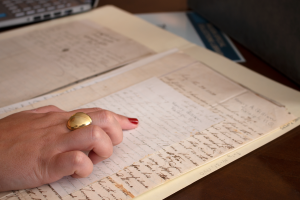Southern Futures Townsend Fellow Cayla Colclasure is studying the prison labor that built the Western North Carolina Railroad, which weaves through Old Fort in McDowell County, North Carolina.

Cayla Colclasure flips through maps, letters, U.S. Census records and reports related to the Western North Carolina Railroad in the research room in the Wilson Special Collections Library.
Colclasure, a Ph.D. student in anthropology and a Southern Futures Townsend Fellow, is researching the prison labor that built the railroad, particularly as it passes through the mountain town of Old Fort, North Carolina. The rail line remains active; freight trains still lumber through daily, past the small yellow train depot downtown.
“The railroad was built using prison labor under the convict leasing system that was instated in the late 19th century post-Emancipation to continue to exploit free labor, especially from the Black population,” she said. “Black people were often arrested for petty crimes like larceny in what became known as ‘Black codes’ and sent to labor camps.” Colclasure also received a Wilson Library Pre-Dissertation Prospectus Fellowship to support her summer research.
The 1880 U.S. Census provided her with a list of the convicts from Old Fort Township. She shared a letter written on July 26, 1880, asking for the pardon of 20-year-old Lucy Morgan, one of the few female laborers at the camp, who was convicted of larceny. Women would have performed jobs like laundry and cooking.

“I’m interested in the camps (built in the 1870s and 1880s) and the material record and what’s left behind and how that can add context to history,” she said. “The use of prison labor continued well into the 20th century for many infrastructure projects.”
“Maps and aerial imagery can tell us the locations of the some of the stockades, but I’m also interested in how they were constructed. Did they use bricks or timber? How large were they?”
More than 3,000 laborers were used to build the railroad. It was dangerous work, involving blasting tunnels through mountain rock. “It was the first use of nitroglycerine in the Southeast, and there were landslides and cave-ins all the time. Imprisoned laborers also died of exposure to disease or died trying to escape,” she said.
Her work is part of larger project that is helping to tell a more complete history for Old Fort as the town positions itself to take advantage of a growing outdoor recreation economy in the region. [See a fall ’22 Carolina Arts & Sciences magazine story on this work, also supported by Southern Futures.]

A memorial was dedicated last fall to honor the incarcerated workers who built the railroad; the effort was spearheaded by the RAIL Project, which is led by a UNC-Asheville historian. She has made multiple trips to Old Fort, searching for photos of the stockades in the town’s Mountain Gateway Museum and at the Pack Memorial Public Library in Buncombe County.
“Everyone in Old Fort is so invested in their community and cares so deeply about what the future is going to be,” she said. “Part of charting a future always involves a reflection on the past. I’m grateful to be invited to contribute to the conversation in this way.”
Colclasure’s research focuses on issues related to heritage and history in the American South. She received a B.A. in anthropology from the University of Tennessee, Knoxville, and an M.A. in anthropology from the University of Alabama. She is working to complete her certification in community-based participatory research.
In 2021, she received a Humanities for the Public Good Fellowship to support work with the North Carolina Museum of History in Raleigh. She helped to develop the American Indian Heritage Celebration and the African American Cultural Celebration. She also organized a “hands-on history day” based on an exhibit at the museum focused on underwater archaeology.
“I have a passion for education,” she said. “I ended up on this path in archaeology because I wanted to contribute to uncovering untold stories in communities and to work with them to understand what’s important and how best to share that knowledge.
“I want my work to not just end up in academic journals but for it to be accessible to people in the community.”
By Kim Weaver Spurr ’88
UNC-Chapel Hill celebrates University Research Week Oct. 10-14. Stay tuned to the College website all week as we publish stories about student and faculty researchers.
